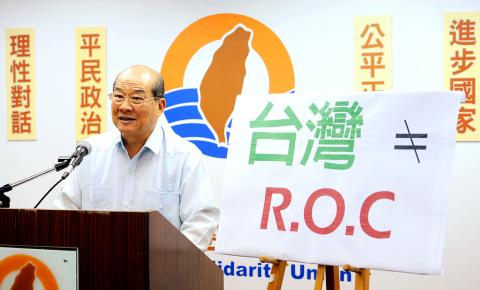Academics and politicians continued to express mixed reactions yesterday to Democratic Progressive Party (DPP) Chairperson Tsai Ing-wen’s (蔡英文) “recognition” of the Republic of China (ROC) last weekend, with some members of the pan-green camp voicing strong disapproval.
While most people, including the DPP’s rival in the January presidential elections the Chinese Nationalist Party (KMT), welcomed the statement, some DPP members expressed displeasure over Tsai’s statement, with DPP Legislator Twu Shiing-jer (涂醒哲) saying that Taiwan is not the ROC and that its status remains undecided.
Tsai, the DPP’s presidential candidate, repeated her call for members of the pan-green camp to support her willingness to recognize the ROC on Monday night in a campaign stop in Chiayi City.

Photo: Lo Pei-der, Taipei Times
Taiwanese were able to “absorb the ROC in” 60 years, she said, so that the KMT should be more closely identified with Taiwan by now.
She also said that Taiwan was more than a geographical term or a “homeland,” as President Ma Ying-jeou (馬英九) said in his national day speech on Monday, but a place with a “meaning of sovereignty.”
Media quoted analysts as saying that Tsai’s statement was “not surprising” and was in line with the DPP’s resolution on Taiwan’s future in 1999, which stated that Taiwan is an independent and sovereign country currently using the name ROC.
Tsai’s interpretation of the ROC differs from Ma’s, which still defines the ROC as the country -established by Sun Yat-sen (孫逸仙) in 1912 and which consists of 35 provinces, including modern-day Mongolia, former Mainland Affairs Council chairman Joseph Wu (吳釗燮) told a forum organized by the Taiwan Brain Trust.
The ROC that Tsai recognized is a country with the territories of Taiwan, Penghu, Kinmen and Matsu, a country that remade itself after being expelled from the UN in 1971, Wu said.
Most Taiwanese would be able to relate to Tsai’s interpretation of the ROC better than that of Ma’s, which holds the view that the ROC — and only the ROC — holds sovereignty and Taiwan is and has always been only part of the ROC, he said.
Meanwhile, the Taiwan Solidarity Union (TSU), a DPP ally, expressed its disagreement with Tsai, saying that “Taiwan is not the ROC and the ROC is not Taiwan.”
“Taiwan is Taiwan. It is a de facto independent country. The TSU always maintains that what Taiwan really needs is name rectification and a new constitution,” TSU Chairman Huang Kun-huei (黃昆輝) told reporters at a separate press conference.
Taiwan was not an ROC territory when the ROC was founded in 1912, nor did Taiwan send representatives to the ROC Constitutional meeting in 1936, which was why former president and TSU spiritual leader Lee Teng-hui (李登輝) characterized it as “the ROC in Taiwan,” Huang said.
Lee referred to the current situation as “the ROC in Taiwan” because dictator Chiang Kai-shek (蔣介石) and his KMT troops brought “the ROC system” to Taiwan after their defeat in the Chinese Civil War in 1949 without first securing the consent of Taiwanese, Huang said.

LIMITS: While China increases military pressure on Taiwan and expands its use of cognitive warfare, it is unwilling to target tech supply chains, the report said US and Taiwan military officials have warned that the Chinese People’s Liberation Army (PLA) could implement a blockade within “a matter of hours” and need only “minimal conversion time” prior to an attack on Taiwan, a report released on Tuesday by the US Senate’s China Economic and Security Review Commission said. “While there is no indication that China is planning an imminent attack, the United States and its allies and partners can no longer assume that a Taiwan contingency is a distant possibility for which they would have ample time to prepare,” it said. The commission made the comments in its annual

DETERMINATION: Beijing’s actions toward Tokyo have drawn international attention, but would likely bolster regional coordination and defense networks, the report said Japanese Prime Minister Sanae Takaichi’s administration is likely to prioritize security reforms and deterrence in the face of recent “hybrid” threats from China, the National Security Bureau (NSB) said. The bureau made the assessment in a written report to the Legislative Yuan ahead of an oral report and questions-and-answers session at the legislature’s Foreign Affairs and National Defense Committee tomorrow. The key points of Japan’s security reforms would be to reinforce security cooperation with the US, including enhancing defense deployment in the first island chain, pushing forward the integrated command and operations of the Japan Self-Defense Forces and US Forces Japan, as

‘TROUBLEMAKER’: Most countries believe that it is China — rather than Taiwan — that is undermining regional peace and stability with its coercive tactics, the president said China should restrain itself and refrain from being a troublemaker that sabotages peace and stability in the Indo-Pacific region, President William Lai (賴清德) said yesterday. Lai made the remarks after China Coast Guard vessels sailed into disputed waters off the Senkaku Islands — known as the Diaoyutai Islands (釣魚台) in Taiwan — following a remark Japanese Prime Minister Sanae Takaichi made regarding Taiwan. Takaichi during a parliamentary session on Nov. 7 said that a “Taiwan contingency” involving a Chinese naval blockade could qualify as a “survival-threatening situation” for Japan, and trigger Tokyo’s deployment of its military for defense. Asked about the escalating tensions

The Ministry of Economic Affairs said it plans to revise the export control list for strategic high-tech products by adding 18 items under three categories — advanced 3D printing equipment, advanced semiconductor equipment and quantum computers — which would require local manufacturers to obtain licenses for their export. The ministry’s announcement yesterday came as the International Trade Administration issued a 60-day preview period for planned revisions to the Export Control List for Dual Use Items and Technology (軍商兩用貨品及技術出口管制清單) and the Common Military List (一般軍用貨品清單), which fall under regulations governing export destinations for strategic high-tech commodities and specific strategic high-tech commodities. The